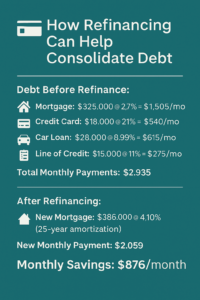
For many, juggling multiple payments on credit cards, auto loans, and lines of credit is overwhelming.
Refinancing can be the solution—not to get a lower mortgage rate, but to simplify finances and reduce total monthly outflow by consolidating debt into one manageable payment.
📉 Why Consolidate Debt Through a Refinance?
Instead of making multiple payments to lenders charging 8%, 12%, or even 21% interest, you may be able to roll those balances into your mortgage at a rate closer to 4–5%, depending on your credit and equity.
Here’s what that can look like in real terms:
🧾 Realistic Example – Debt Before Refinance:
-
Mortgage: $325,000 @ 2.79% = $1,505/month
-
Credit Card: $18,000 @ 21% = $540/month
-
Car Loan: $28,000 @ 8.99% = $615/month
-
Line of Credit: $15,000 @ 11% = $275/month
-
Total Monthly Payments: $2,935
🏡 After Refinancing:
-
New Mortgage: $386,000 @ 4.10% (25-year amortization)
-
New Monthly Payment: $2,059
-
Monthly Savings: $876/month
You’ve eliminated all high-interest payments and replaced them with a single mortgage payment at a lower blended rate.
🛠️ When This Strategy Works Best
Refinancing to consolidate debt is most effective when:
-
You have strong equity (typically at least 20%)
-
Your credit is still in good standing
-
You’re looking to free up cash flow or prevent missed payments
-
You want to simplify your monthly obligations
Even if your new mortgage rate is higher than your current one, the overall interest savings and stress relief can be substantial.
🚫 When to Pause
Refinancing to consolidate debt may not be ideal if:
-
You’re early in your mortgage term and facing large penalties
-
Your home equity is low
-
Your income has dropped significantly, affecting qualification
In those cases, a second mortgage or private lending solution may be better—especially short-term.
💬 Final Thoughts
High-interest debt doesn’t just drain your bank account—it affects your mental space. A strategic refinance can be the key to restoring balance, regaining cash flow, and setting your financial life on a new track.
Every case is unique. Even if refinancing isn’t the final solution, it’s worth a conversation to explore your options before debt becomes unmanageable.